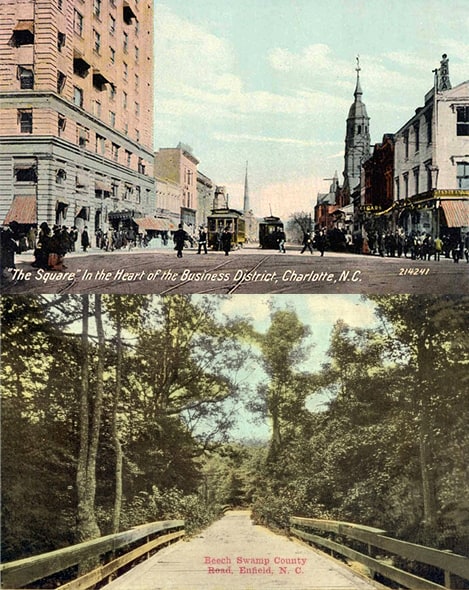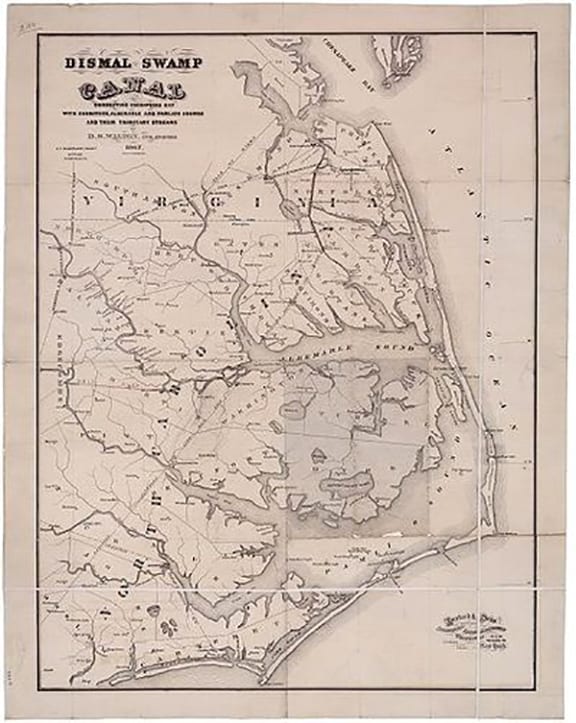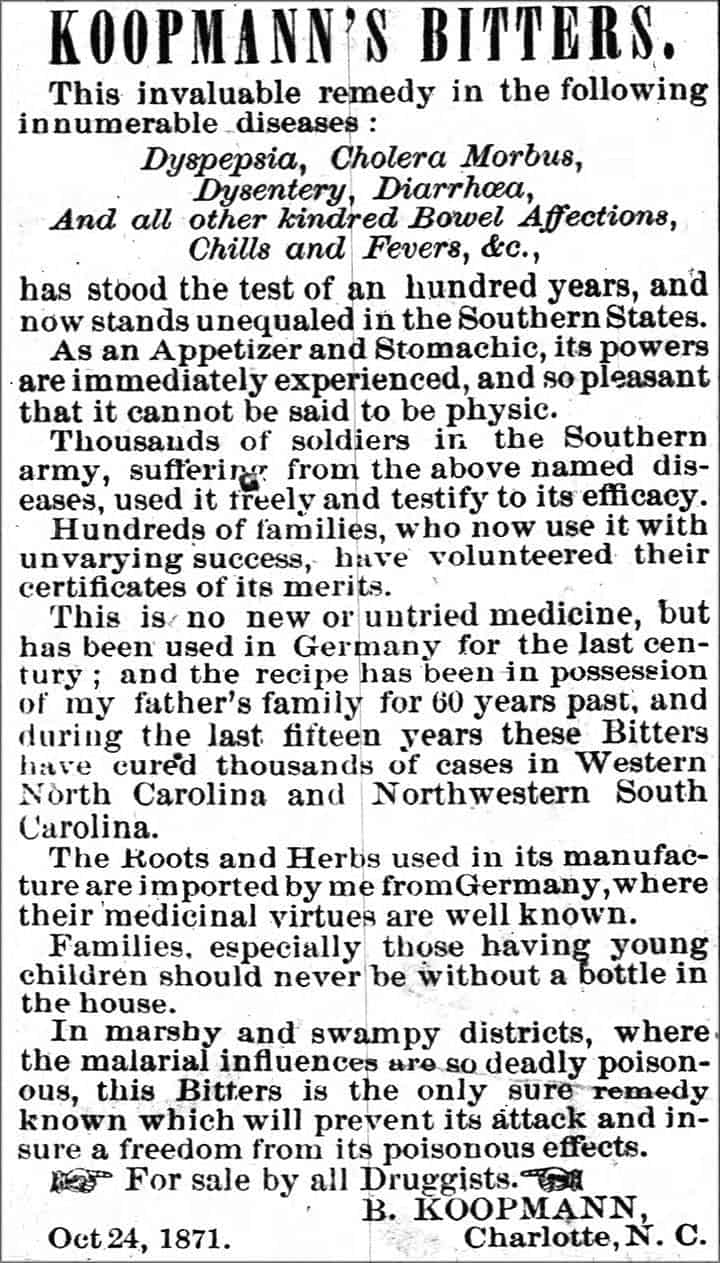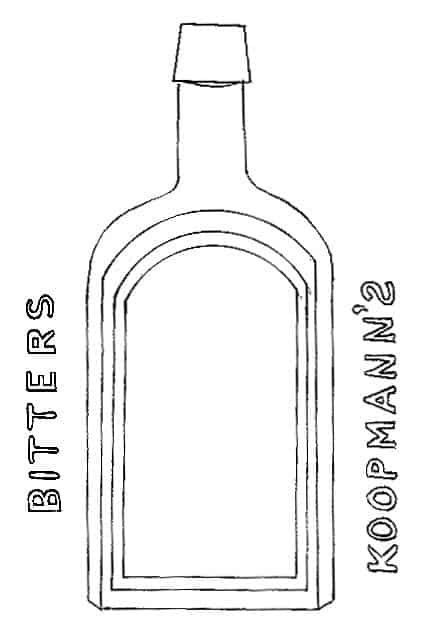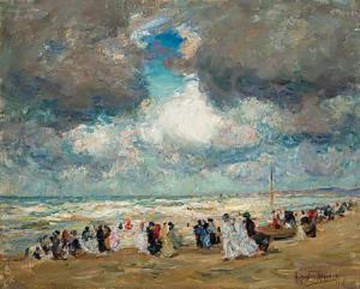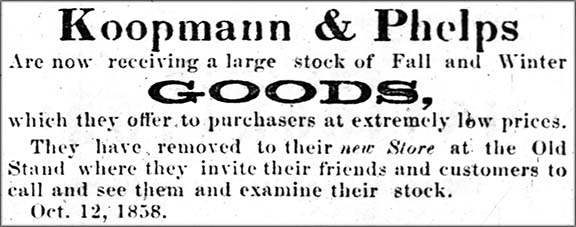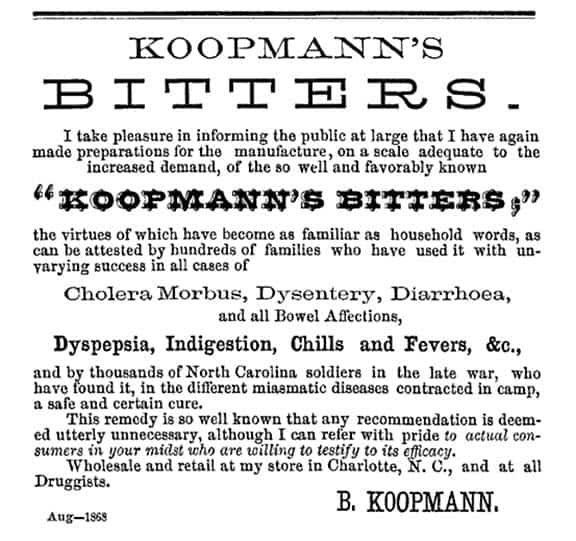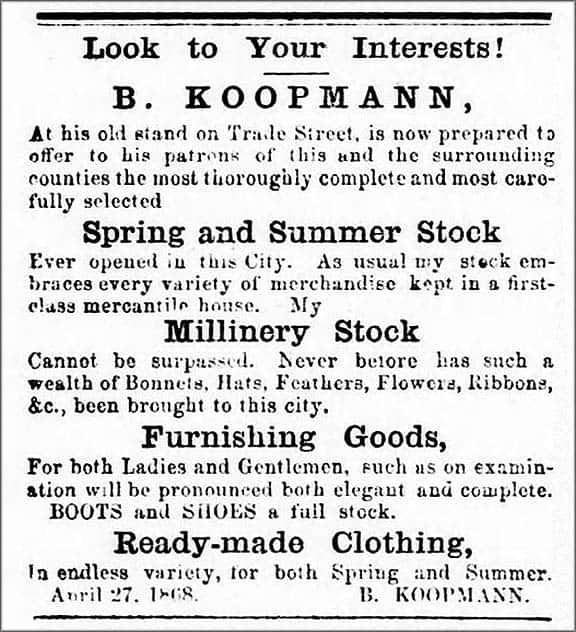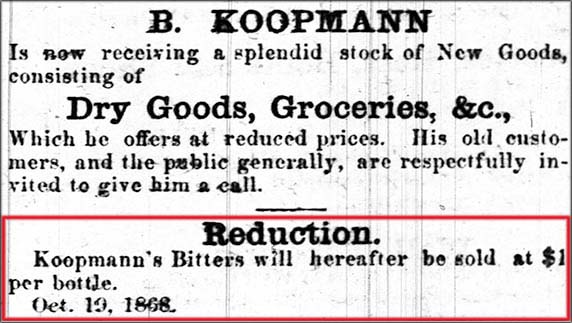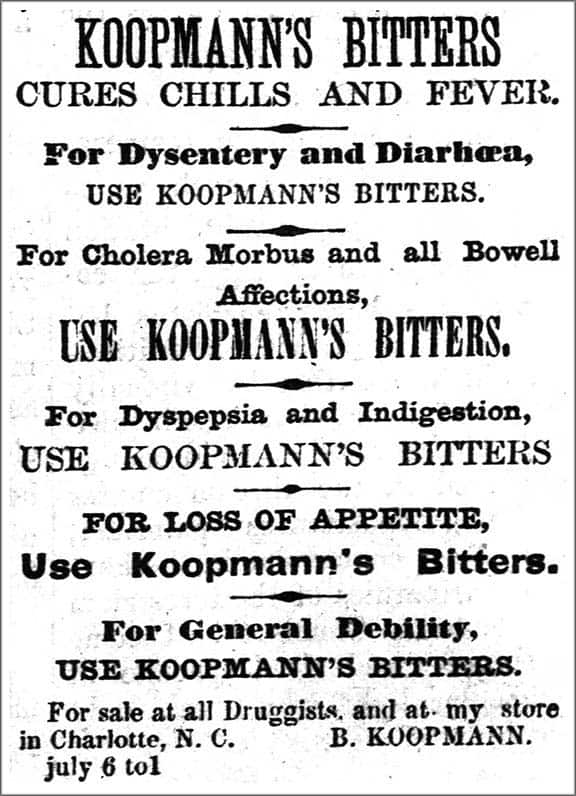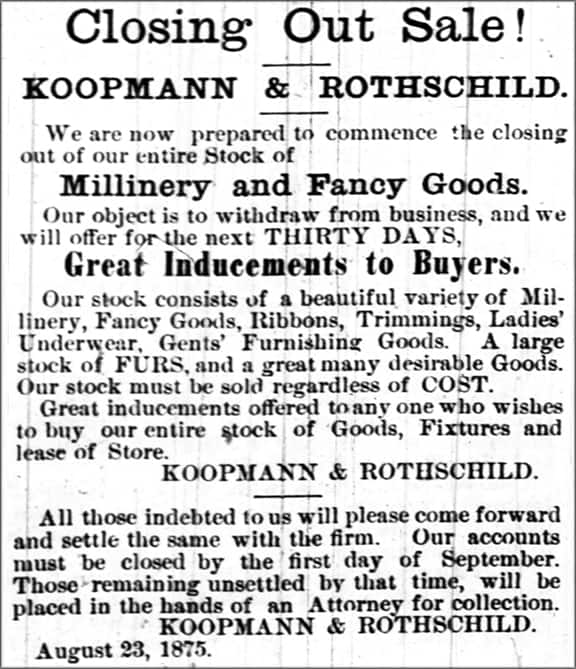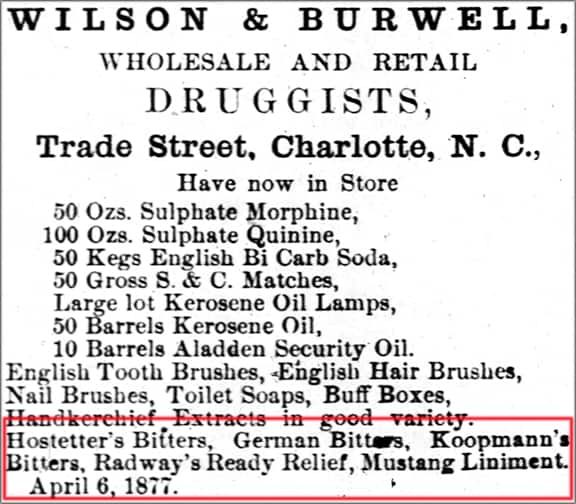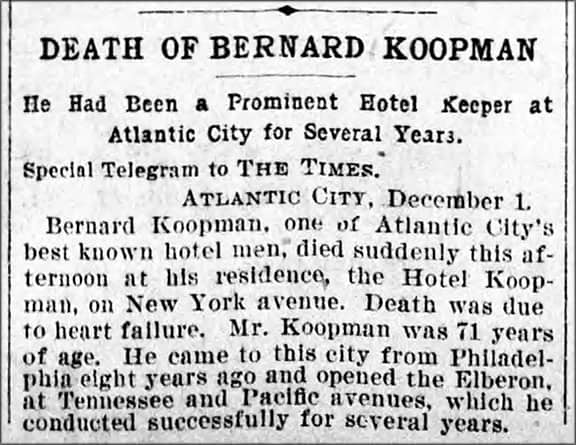Koopmann’s Bitters, for use in Marshy and Swampy Districts
15 December 2014 • Updated 21 August 2016 • R-081618
![]() I came across this advertisement below for Koopmann’s Bitters put out by B. Koopmann in Charlotte, North Carolina around 1871. Let’s check it out. Koopmann said in 1871, that his bitters “has stood the test of a hundred years” saying it had been used in Germany and the recipe was in the possession of his father’s family for the last 60 years. He said that in the “past fifteen years these Bitters have cured thousands of cases in Western North Carolina and Northwestern South Carolina.” I suppose those are the marshy and swampy districts.
I came across this advertisement below for Koopmann’s Bitters put out by B. Koopmann in Charlotte, North Carolina around 1871. Let’s check it out. Koopmann said in 1871, that his bitters “has stood the test of a hundred years” saying it had been used in Germany and the recipe was in the possession of his father’s family for the last 60 years. He said that in the “past fifteen years these Bitters have cured thousands of cases in Western North Carolina and Northwestern South Carolina.” I suppose those are the marshy and swampy districts.
In marshy and swampy districts, where the malarial influences are so deadly poisonous, this Bitters is the only sure remedy known which will prevent its attack and insure a freedom from its poisonous effects.
At first I thought that the Koopmann’s Bitters was unlisted though Carlyn Ring and W.C. Ham do have a K | 73 listing for a Kookman’s Bitters in Bitters Bottles referencing a Louisville, Kentucky bitters from a newspaper advertisement. Imagine having Kookman as a last name. When you look at Bitters Bottles Supplement, there is a listing for a Koopmann’s Bitters saying an example was dug in Iowa in the 1970s. This is odd, a bitters made for the swampy districts of the Carolinas being found in Iowa. It migrated west if it is the same bitters.
K 73.5 KOOPMANN’S BITTERS
// sp // KOOPMANN’S // sp // BITTERS
8 1/8 x 3 3/8 x 2 (5 1/2)
Rectangular, Aqua, LTC, Applied mouth, 4 sp, Extremely rare
The “S” in KOOPMANN’S is backwards, Lettering starts at base and reads upward.
Example was dug in Iowa in the 1970s.
21 August 2016: Koopmann’s Bitters dug in Savannah
Bernard Koopmann (sometimes spelled Koopman), was born in Oldenburg, Germany around 1824. His wife is Johanna. Koopmann shows up in Statesville, North Carolina records as a Jewish merchant around 1856 prior to moving to Charlotte in the late 1850s as a retail merchant at Koopmann & Phelps. In Statesville, Wallace & Elias advertise his Koopmann’s Celebrated Bitters. Koopmann moves to a new store in October 1858 at The Old Stand which I believe to be in the downtown Trade and Tryon Street area, as just about everything of importance was at that time in Charlotte. The Koopmann’s Anti-Dysenteric and Anti-Dyspeptic Bitters makes an appearance in advertising at the same time. The bitters probably was first sold in 1856 in Statesville based on the advertising statement I mentioned earlier.
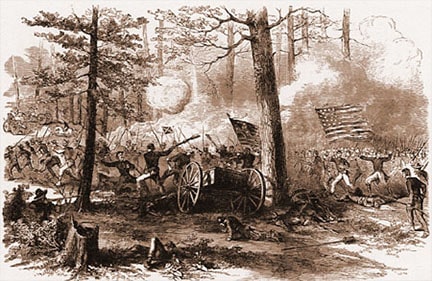
Mower’s Union troops attack the Confederate left flank, March 21, 1865, Battle of Bentonville – Frank Leslie’s Illustrated Newspaper
After the The Battle of Bentonville, the southern Civil War wounded were moved to Koopmann & Phelps along with many other locations in Charlotte. Bentonville produced 2,500 or so Confederate casualties. Koopmann’s Bitters are reduced in price to a $1 dollar a bottle in 1868 indicating either an abundance or less popularity of the product. Koopmann seems to be on his own in 1868 as Phelps drops from the name.
Around 1870, there are listings for Koopmann & Rothschild with Bernard Koopmann and Jacob Rothschild as partners. They start a new mercantile company selling the bitters, millinery, white goods and notions on Trade Street between Tryon and Church. Sales continue through the early to mid 1870s with Elias Koopmann helping with the bitters marketing. Koopmann & Rothschild dissolve in 1875 though the bitters continues to be sold by Wilson & Burwell in Charlotte up until 1877. Surprising, there are not more examples of this extremely rare bottle.
Bernard Koopmann dies in Atlantic City, New Jersey on December 1, 1895 where he is the proprietor of a hotel. He is buried in Philadelphia.
As a side note, I believe Bernard Koopmann may have been the father of the famous artist Augustus B. Koopman (1869-1914). Born in Charlotte, North Carolina, Augustus Koopman was a painter and etcher of subjects that included the American West. He lived only 45 years and spent most of his short life in Paris where he was a member of an extensive expatriate community in Montparnasse. He also did much painting of marine and figurative subjects at Etaples, along the coast near Belgium. Koopman studied at the Pennsylvania Academy of Fine Arts, and in Paris between 1887 and 1892, at the Academie Julian.
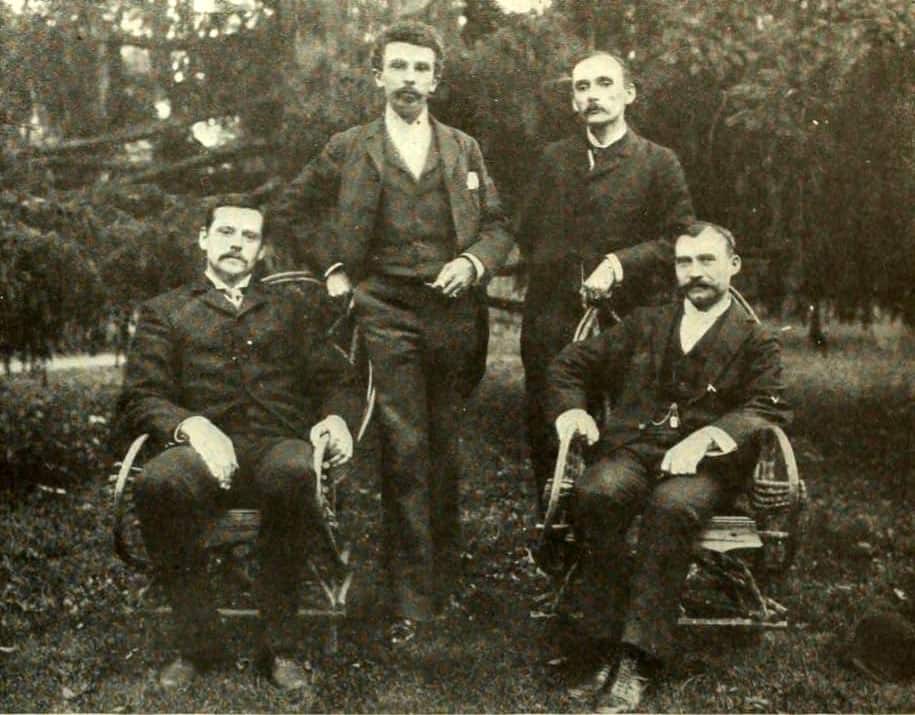
First meeting of the members of the K.M.C.D. Syndicate on September 22, 1895, from left: Henry N. Marvin, William Kennedy Laurie Dickson, Herman Casler, and Elias Bernard Koopman Elias Bernard Koopman (1860 – August 23, 1929) was a founder of the American Mutoscope and Biograph Company.[1] He was also a founder of the The Magic Introduction Company. He later headed the Runsyne Corporation, a maker of electrical signs.
Prior to Elias Koopman founding of the American Mutoscope and Biograph Company, he was also the founder of The Magic Introduction Company. He later headed the Runsyne Corporation, a maker of electrical signs. Jason Champlin points out interesting enough, there was a bottle made from the Magic Introduction Company (see below).
Koopman committed suicide by stabbing himself in the abdomen in 1929 in the Hotel Cumberland. He was taken to the hospital while still alive, but he died a few hours later. He left a note for his brother, Harry Koopman telling him of his intentions. In the note he asked that his family not mourn for him. He also asked that his body be donated to science. He was 69 years old. [Wikipedia]
Select Listings
1858: Koopmann & Phelps change of address – The Charlotte Democrat, Tuesday, October 26, 1858
1860: Koopmann’s Anti-Dysenteric and Anti-Dyspeptic Bitters advertisement (see below) – The Charlotte Democrat, Tuesday, March 13, 1860
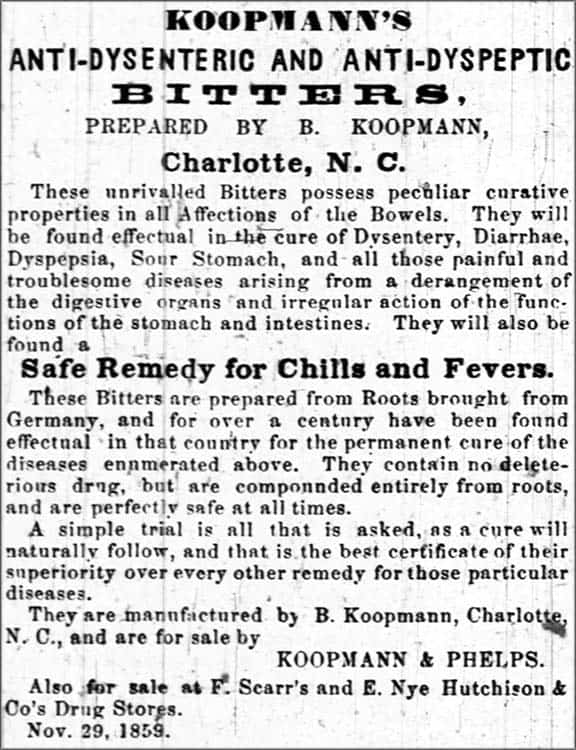
Koopmann’s Anti-Dysenteric and Anti-Dyspeptic Bitters advertisement – The Charlotte Democrat, Tuesday, March 13, 1860
1861: Koopmann & Phelps Wholesale and Retail Dry Goods Merchants advertisement (see below) – The Evening Bulletin (Charlotte, North Carolina), Friday, August, 9 1861.
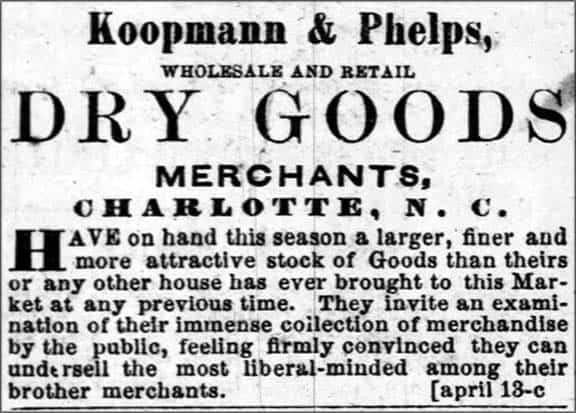
Koopmann & Phelps Wholesale and Retail Dry Goods Merchants advertisement – The Evening Bulletin, Friday, August, 9 1861.
1861: Koopman’s Bitters advertisement (see below, note misspelling) – The Evening Bulletin, Tuesday, December 17, 1861
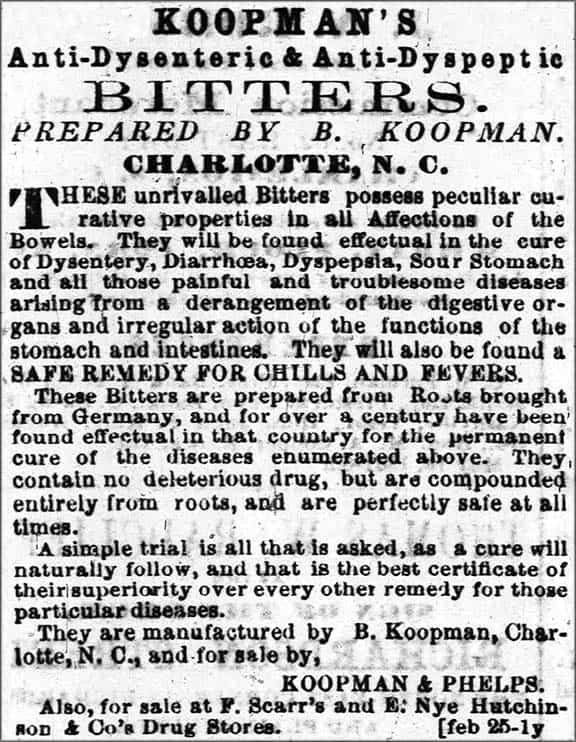
Koopman’s Bitters advertisement (note mispelling) – The Evening Bulletin, Tuesday, December 17, 1861
1865: The Battle of Bentonville (March 19–21, 1865) was fought in Bentonville, North Carolina, near the town of Four Oaks, as part of the Carolinas Campaign of the American Civil War. It was the last battle between the armies of Union Maj. Gen. William T. Sherman and Confederate Gen. Joseph E. Johnston. Casualties at Koopmann & Phelps.
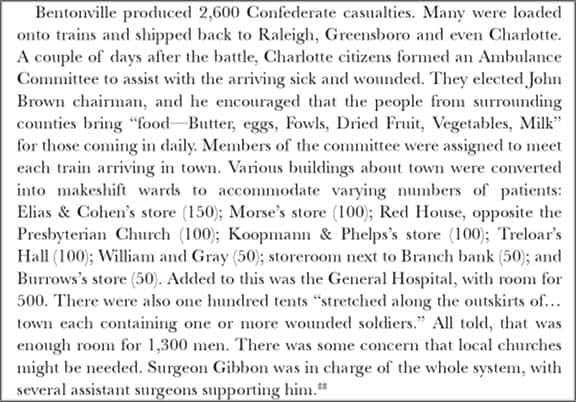
100 Bentonville casualties at Koopmann & Phelps – Civil War Charlotte: Last Capital of the Confederacy by Michael C. Hardy
1866-1867: Koopmann & Phelps, merchants, Charlotte. – Branson & Farrar’s North Carolina Business Directory for 1866-67
1866: B. Koopmann Tax Assessment, Retail Dealer, Charlotte
1868: Koopmann’s Bitters advertisement (see below) – The Land We Love, 1868
1868: B. Koopmann mercantile house advertisement (see below) – The Western Democrat (North Carolina) July 21, 1868
1868: Koopmann’s Bitters price reduced (see below) – The Charlotte Democrat, Tuesday, October 20, 1868
1869: Koopmann’s Bitters advertisement (see below) – Daily Charlotte Observer, Saturday, September 25, 1869
1871: Koopmann’s Bitters advertisement (see top-most subject post advertisement) – The Southern Home, Tuesday, December 19, 1871.
1875: Koopmann & Rothschild, (Bernard Koopmann and Jacob Rothschild) (Elias B. Koopmann, clerk (*listed as selling the bitters), millinery, white goods and notions, Trade between Tryon and Church – Beasley & Emersons Charlotte Directory
1875: Koopmann & Rothschild Closing Out notice (see below) – The Charlotte Democrat, Monday, September 6, 1875.
1877: Wilson & Burwell selling Koopmann’s Bitters (see below) – The Charlotte Democrat, Friday, April 27, 1877.
1895: Bernard Koopmann dies in Atlantic City, New Jersey (see below) on December 1, 1895.
1970s: Koopmann’s Bitters example is dug in Iowa in the 1970s.

